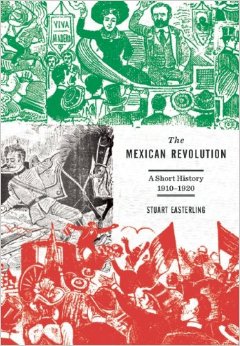 Easterling makes a reasonable clarification of the chaos of the Mexican Revolution—as he says “…ten years of social conflict, deprivation, and bloody warfare.” He skims through the ten-year revolution with seminal characters in this petite book as:
Easterling makes a reasonable clarification of the chaos of the Mexican Revolution—as he says “…ten years of social conflict, deprivation, and bloody warfare.” He skims through the ten-year revolution with seminal characters in this petite book as:
- Profirio Diaz (1839-1915). Dictator of Mexico from 1884 to 1911. Overthrown by
- Gustavo Madero (1875-19130. President 1911 to 1913. An advocate for social justice but not for distribution of the land to the peasants. Overthrown and assassinated by
- General Victoriano Huerta (1850-1916). President from 1913 to 1914. Established a harsh military dictatorship. The Constitutionalist Army consisting of the bandit/revolutionary Francisco “Pancho” Villa and his Northern Army, Emiliano Zapata and his Liberation Army of the South, and disaffected generals including Álvaro Obregón, Huerta was overthrown by
- Venustiano Carranza (1859-1920). President from 1917 to 1920. Promised to restore the constitution of 1857 but did not affirm social reform. He waged war against Villa and Zapata—subduing both. Corruption was rampant in his administration. He declined to participate in the 1920 presidential election. His best general/politician,
- Álvaro Obregón (1880-1928) won the election and after a time brought a semblance of order to Mexico. He was ssassinated in 1928.
He assiduously avoids discussing the military campaigns, except in passing. He focuses instead on the personalities, their interactions, and affect on the populace and their reactions. To discuss, even in minor detail, the military operations, would have significantly clarified many passages that seem incongruous or the lack of a raison d’être for subsequence actions.
Unfortunately, Easterling’s narrative has several major construct problems.
- Far too often Easterling leaves out important details in his narrative.
- For example. During the 1915 presidential campaign, we learn that First Chief (President) Venustiano Carranza would not support his general, Álvaro Obregon as a candidate. Questions: Did Carranza decide on a second term? If not, why not. Would Obregon be his rival? This key information is not stated and is perplexing. (I found the answer on Wikipedia.)
- Another example: He mentions the “The Red Battalions,” but does not explain who they are, their loyalty, or what was their function in the Revolution.
- From time-to-time, his syntax introduces confusion in the narrative. For example, “Following the capture of a train hub that had been in Constitutionalist hands, some ninety soldaderas, their men now dead or wounded, were assembled and awaiting their fate.”
Throughout, this Haymarket publication (Chicago labor riots in 1886) is imbrued with Marxists phrases and jingoism. Here are several “collective organization, communal landownership, agrarian revolutionaries, anarcho-syndicalism, agitated for radical change, undermine the legitimacy of the regime, agrarian radicalism, capitalist economic transformation, dictatorial political system, urban proletariat, agrarian socialism, and social revolution, tyranny of capitalism.”